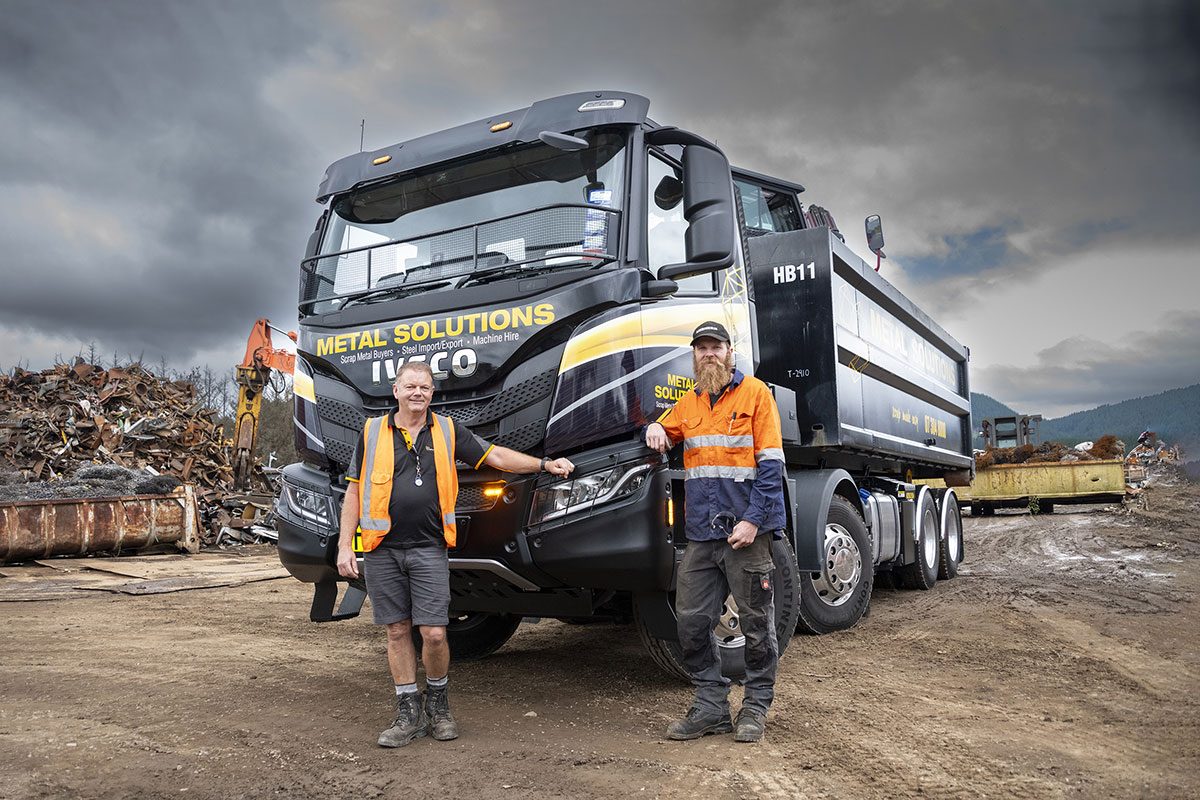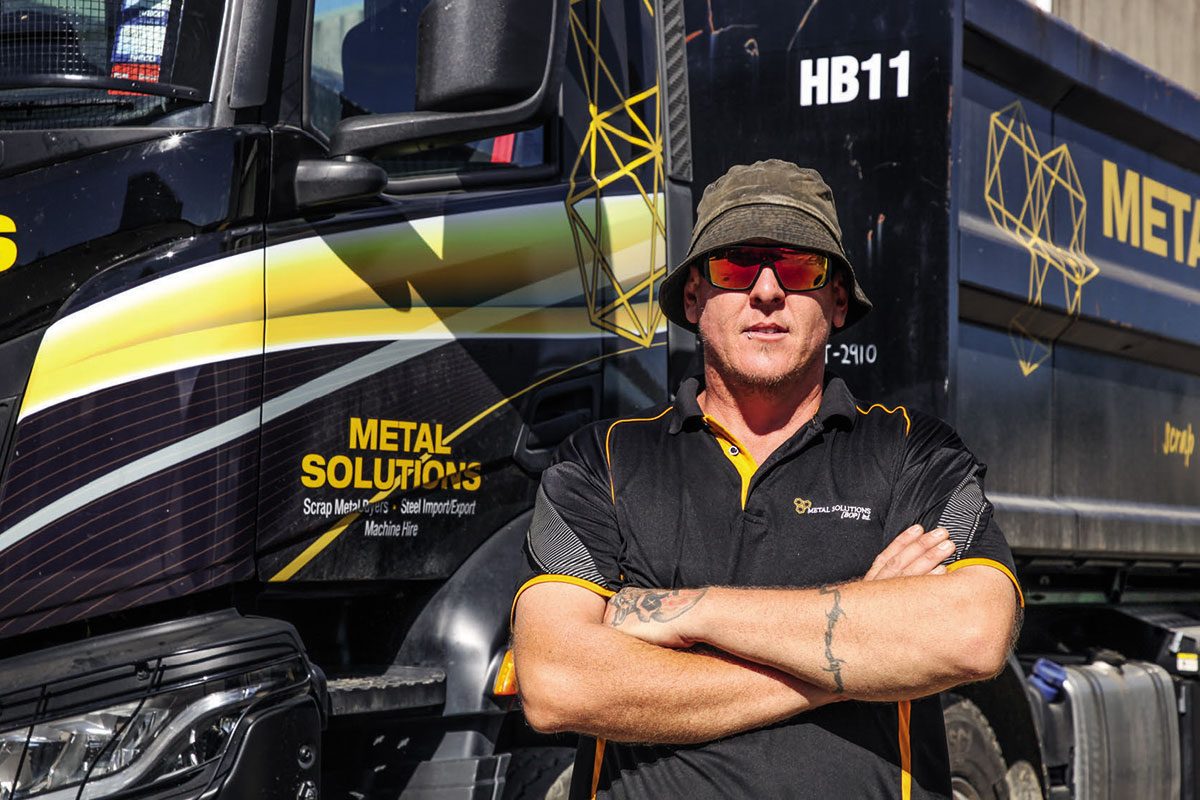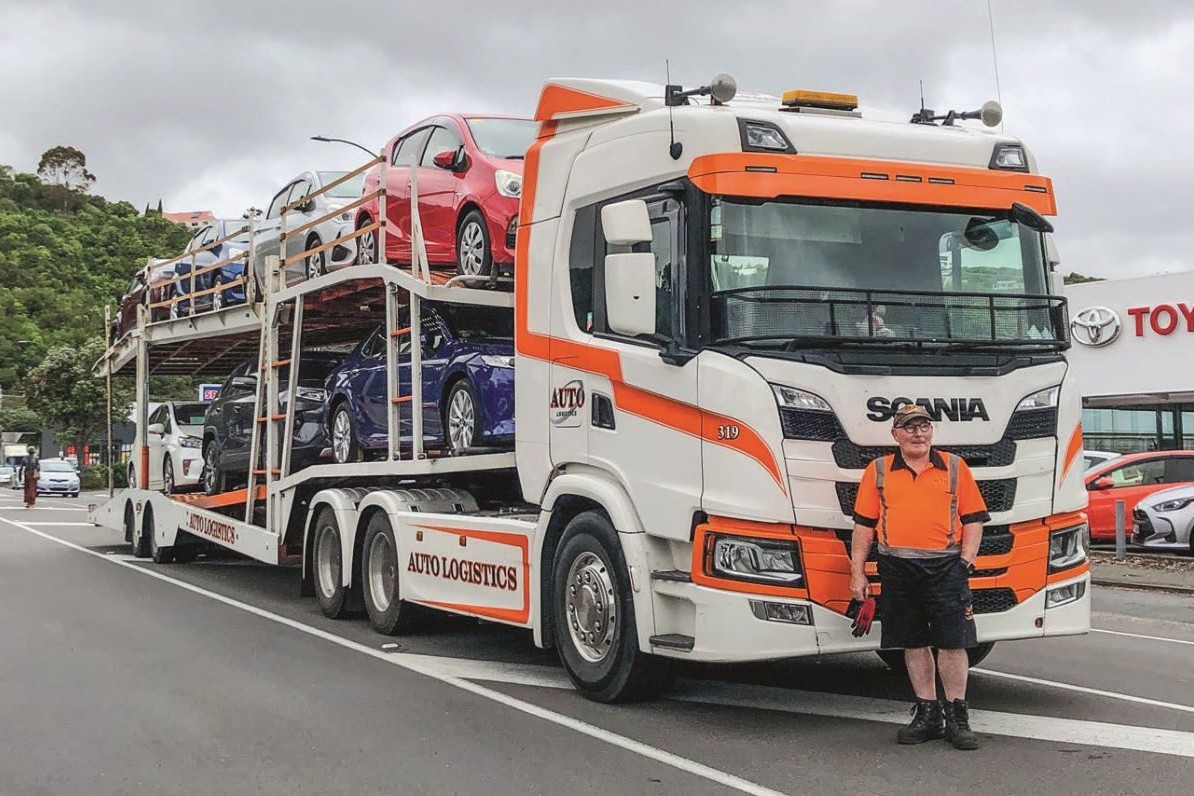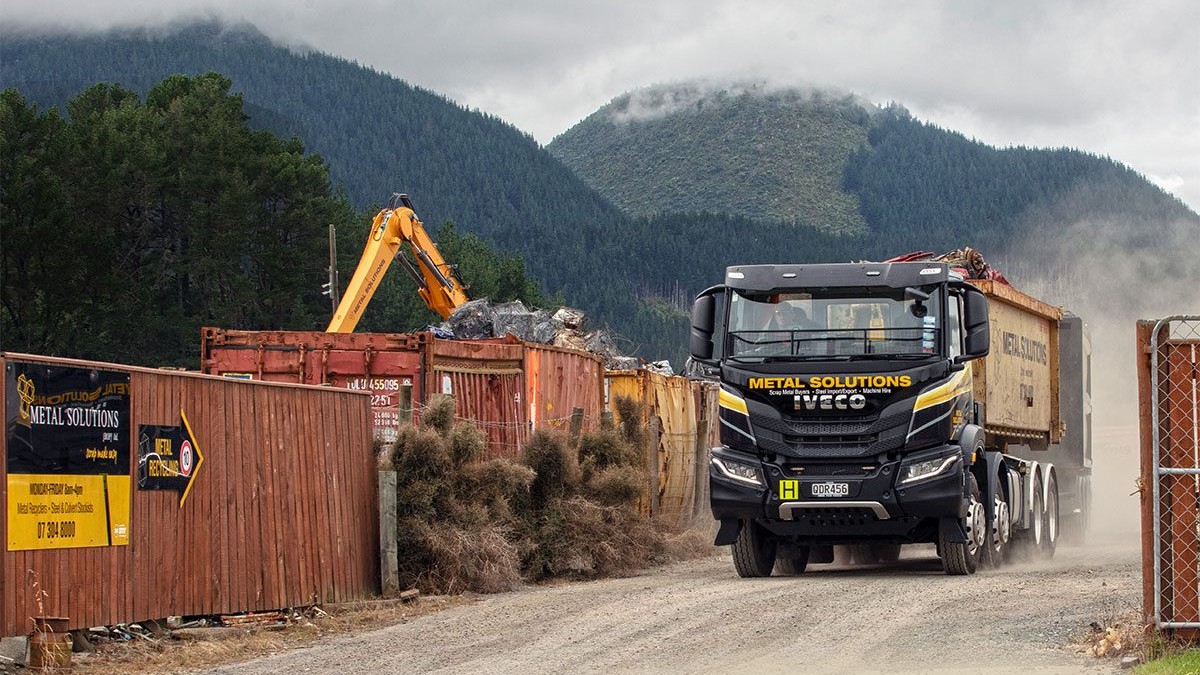
The IVECO T-Way is the latest in a family of ultra-capable, hard-working, and race- proven, trucks. It has a lot to live up to. But it’s nuggety, plucky, tenacious and intelligent – all traits that should set it up for success.
Iveco launched the S-Way in New Zealand just over a year ago. It’s fair to say that – as it’s done overseas – S-Way has been nothing but a success, boosting Iveco New Zealand’s profile among drivers, operators and on the sales charts. Take a trip along the nation’s highways and byways and S-Ways are seemingly everywhere.
At that launch in late February 2023, much was made about the S-Way’s safety, efficiency, performance and design enhancements, as well as its focus on driver comfort.
When we jumped aboard the Titus Transport 570hp 6×4 S-Way for our June 2023 cover story, it was abundantly clear IVECO had delivered on all fronts. S-Way was the product we’d all hoped it would be – one that would build on the foundational ability set by X-Way on our roads since 2020, simultaneously catapulting the brand’s heavyweight offering into a new era and giving its rivals something to sit up and take notice of.
But alongside the S-Way, presented at the launch in various model configurations, was a lone IVECO T-Way 410 4×4. A replacement for the brawny Trakker, it, perhaps unfairly, didn’t quite attract the same attention as the star of the show on the day.

Its importance to the new range, however, was beyond question – with Iveco New Zealand choosing not to debut the range- topping 510hp model, but rather the 410hp 4×4, a model Iveco New Zealand medium and heavy truck sales executive Pieter Theron introduced as “a benchmark for severe off-road applications”.
Around the time we’d joined Titus Transport driver Scott Parker for a burn in the S-Way, order books for the complete T-Way range had opened, and full details on the range had been released. For those tasked with tackling goat tracks instead of graded, sealed roads, it all made exciting reading – but the application of that level of ruggedness is niche for any mainstream OEM, and with the T-Way’s talents stretching impressively wide, finding the right truck in the right application to get our first taste of the T-Way should’ve been easy enough.
Kawerau-based Metal Solutions’ eye-catching T-Way 510hp hook truck has so far been the poster child for T-Way in New Zealand, and the moment we saw it pop into our inbox as a New Rig on the Road, we thought, “Now there’s a T-Way in an operation we’d love to sample.”

Scrappy-Doo
If ever there were an apt caricature comparison for the new T-Way, it would have to be Hanna-Barbera’s cartoon Great Dane puppy, Scrappy-Doo. Stick with me – there’s more here than just a bad pun … Nuggety, plucky, tenacious and intelligent, Scrappy would often be the one to save the day for Uncle Scooby and bumbling Shaggy. The more time we spent with the MSL T-Way and driver Shannon de Vos, the more those traits came to the fore.
“We get out to some mongrelly places … Yes, they certainly try your driving skills,” says MSL director Dave Fretwell as soon as we start discussing the truck. “The T-Way’s straight front axles and raised ground clearance appealed to us straight off. We did look at an S-Way, it offers a slight tare weight saving, but it’s a different truck completely. We would’ve been ripping off bumpers … I’m pleased with the T-Way.”
Family-owned by Dave, wife Jo and son Chris, and supported by a staff of 16, MSL deals in the recycling of commercial and industrial scrap metal within the upper North Island from its Kawerau base. (See In the middle of an endless cycle.)
A tilter, three high-rise cab handlers, a 10-tonne digger, a Merlo and four trucks support the operation. Forming the core fleet are the T-Way hook truck, an ex-Fonterra Volvo FM crane truck and a four-wheeler Mitsubishi crane tipper that fills in on smaller jobs. The T-Way’s predecessor – a 2012 Actros 480 – is the fourth, still on-hand for the moment, and a new Volvo FM chassis has just arrived to replace the ex-milk hauler.
“She’s high mileage and pretty trashed. We’ll strip the gear off that chassis for the replacement FM,” Dave says.
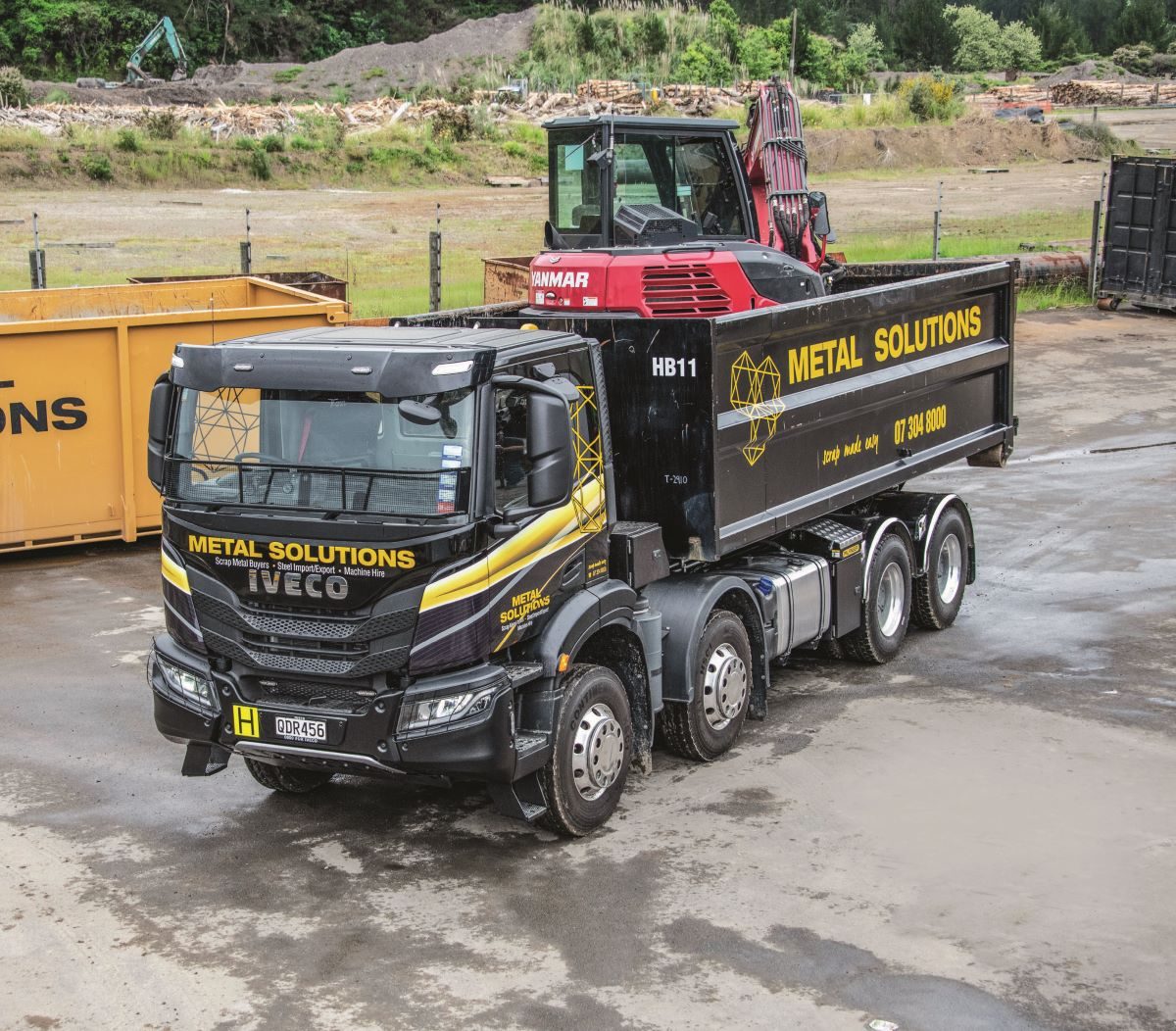
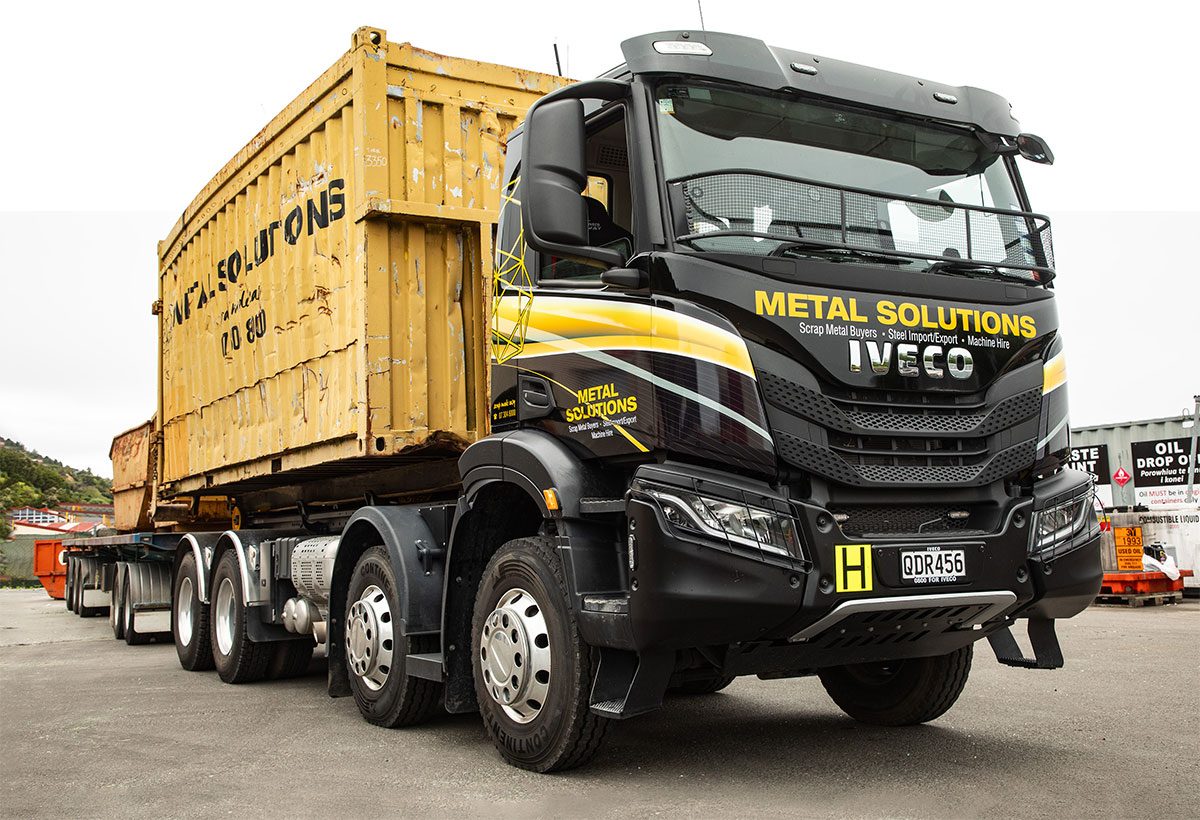
“Scrap is hard on the gear, but we like our fleet to be tidy. We like to operate like that, and we have good staff who work like that too and keep our gear in nice order. When we started, we couldn’t afford to go off and buy new gear, so we had to use our skills to present older gear nicely. Diverse Graphics in Whakatane designed the graphics and still signwrite all our trucks.
“Really, it’s nice to be in a position now where we can afford to go off and buy a couple of new trucks and have that reliability,” he comments.
Volvo, Scania, Isuzu and Fuso were all considered as replacements for the Actros, and Dave ensured he’d done his research in choosing the right truck for the job. “The Japanese trucks went quickly mainly because they don’t have the torque we were after. (A lesson learnt from years of running the poor Actros at 50MAX.)
“I then did a spreadsheet comparing the others, and there wasn’t a lot in it pointing to the Volvo. But, then the T-Way became an option, and comparing that to the Volvo, I found it ticked most of the boxes. Price and availability were also a big part of the decision – it was around $90,000 cheaper than I was quoted for the new Volvo. Looking at what I’d get, I couldn’t see where that difference was. The Volvo was also 12 months out from delivery,” Dave explains.
After a call to Waikato and Bay of Plenty truck sales consultant Brent Landers, Shannon was dispatched to Mt Maunganui IVECO service dealer Diesel Solutions to check out the T-Way, and before long, it was in the Kawerau yard awaiting its fitout.

One man’s trash …
… is another man’s livelihood. And so, in selecting the T-Way, Dave had to be sure he was opting for the right truck for the job, but also that it was spec’d for ultimate productivity.
“We did the fitout of the hydraulics in our workshop. Chris is an engineer. I have an engineering background as well. He looks after all our repairs – tyres, minor servicing, engineering, hydraulics. When you do scrap, you have so much gear and variation in all the gear … So, we’re able to keep the overheads down, and when something of sufficient importance goes wrong, we’re onto it. We don’t have to wait for a call-out,” Dave says.
Koromiko Engineering in Mt Maunganui was drafted to mount the 22-tonne Palfinger T22 Telescopic Hookloader, while a local engineering company applied the finishing touches with custom toolboxes and step plates, and Brad and the team from Coastline Auto Electrical in Whakatane fitted the cameras, hazard beacons, Si Lodec scales, and Eroad.
No day is the same in the scrap game – you could be barely bothering the scales one day, and perilously close to overstepping weight limits and axle loadings the next. Our first meeting with driver Shannon and the T-Way is early on a Monday morning at Waste Management Whakatane, where he’s already loaded two skips of aluminium cans onto the 12m, five-axle flat deck that did duty behind the Actros. Operations manager Rob Watkins introduces us to our chaperone, Terry Southland, and we go in search of the newest, neatest vehicle on site.
“It’s a real nuggety looking thing, isn’t it?” comments Dave McCoid as we approach the T-Way. I agree. “Yeah, looks like it means business. Very cool, I like it.”
Shannon pauses to introduce himself before uncoupling the trailer and nipping to the other side of the yard to swap out a couple of bins. We didn’t yet know it – only watching from the sidelines at this stage – but the T-Way has two very important features that work together to make Shannon’s job immeasurably easier.
The first are a couple of rear-facing cameras, one above the trailer coupling as is common these days, and one on the bumper just over to the driver’s side. “They’re great to check my loading. However, I can actually see the hook with the T-Way’s mirrors, which you can’t on some other trucks,” Shannon comments. Later, Dave adds:
“It doesn’t give you a perfect line-up, but it gives you the height. We found that when we changed to the air-suspension trucks, they don’t always sit at the same height.”
The second handy feature is the T-Way’s 800Nm, engine-mounted switchable PTO. “It’s a game-changer,” Dave remarks. “You can be backing in and just put your foot on the brake, which essentially clutches in, alter the hook height and carry on without having to go into neutral for the PTO. It’s a great feature.”
Load secured, Shannon hits the starter button to head out. Like all modern Euros, the Cursor 13 is whisper-quiet on start-up. It’s a Euro-6e unit, and IVECO’s retained its signature Hi-e SCR after-treatment system, with a few additional planet-friendly acronyms to help it reach the current level of emissions compliancy mandated on its home continent. We’re all familiar with the diesel particulate filter (DPF) and selective catalytic reduction (SCR), but there’s also now a diesel oxidation catalyst (DOC) and a clean up catalyst (CUC). They are all neatly positioned behind the right-hand second steer in what appears a surprisingly compact after-treatment package.
Back at base, Shannon makes a quick swap-out of bins once more and, since the FM is on around-town hiab duty, he hooks up its Koromiko tipping tub trailer to load up for a transfer to Metalco Te Puke. Before leaving, he crosses the on-site Neville Marsh 50T weighbridge. “It’s fantastic, exceptionally accurate,” comments Dave. “We bought a pit weighbridge for a permanent installation, but, with this one, we’ve just never seen the need for it.”
The T-Way is also fitted with SI Lodec scales, a must for a job where the contents and weight of the bin can be a bit of a lottery. “One of the big issues with hook trucks is you’ll often turn up to pick up a bin, and you don’t know what is in it,” he says.
“Sometimes it’s too heavy, and sometimes the payload is okay, but we’re overloaded on one of the axles.” The onboard scales allow Shannon to monitor the axle groups and adjust the bin position accordingly.
Metalco’s scrap deposits now a few tonnes greater, we shoot over to the truck dismantlers at the other end of town for the next bin rotation. This sort of local pick-up, drop-off and swap-out work makes up most of the T-Way’s duties. It does however get to stretch its legs fairly frequently, too. Tomorrow, it’ll be loaded to the brim with non-ferrous metals (aluminium, copper, etc) destined for Phoenix Metalman in Takanini. The 12m flatdeck will be in tow, loaded with full ‘pallets’ – bales all stacked and strapped – and ‘pods’ – IBCs with the tops chopped off.
“This is the metal we don’t have enough volume of to export ourselves,” explains Dave. “So we sell it to them. We would have to wait a long time to justify doing a 20-tonne export load of copper, for example, and it would also impact our cashflow.”
Nitty gritty
We meet Shannon at 6am outside the Mainfreight depot on Truman Lane, Papamoa, where he stops to check his load. Rated at 50MAX, the T-Way is running to Auckland at 49,878kg GCM. With the Kaimais and Bombays ahead of us, we’ll have a couple of opportunities to put its 10hp/tonne potential to the test on the open road – though bearing in mind that, at just 7600km [when we went for our run with Shannon], the T-Way is still loosening up.
Our prior local jobs already proved the T-Way’s ease of manoeuvrability. With its 5820mm wheelbase, IVECO quotes a 21,300mm kerb-to-kerb turning radius. For the odd off-road job, the 29-degree approach angle, 16-degree departure angle and 22-degree ramp angle all combine with the 312mm minimum front ground clearance afforded by that straight front axle (286mm at the rear).
“The first load I did with it, I was at an exit race at a cow shed – they’re renowned for being slippery and getting stuck. I just left the lockers on, and it was fine. When I was doing ag work, the last thing you’d want was to get stuck. I’d love to know how bad it has to be for this to get stuck!” enthuses Shannon. Plucky.
“When Dave asked me if I’d drive an IVECO, I said, ‘Yeah, they drive them in the Dakar! They’re a strong truck, they love off-road!’” he says with a laugh. Rocking mode, off-road mode, creeping mode, and diff cross locks are among the many tools in the T-Way’s ‘get out of jail’ arsenal. Intelligent.
Day-cab trucks can look a little awkward, depending a lot on what’s mounted to the chassis behind it. The T-Way 8×4 is offered with two cabs: AD (1700mm length) and AT (2150mm length, including a 540mm-wide lower bunk). Both measure 2300mm wide and 3100mm high. The MSL truck is an AD cab, but in no way does it look awkward – nuggety, remember – or indeed feel cramped once aboard.
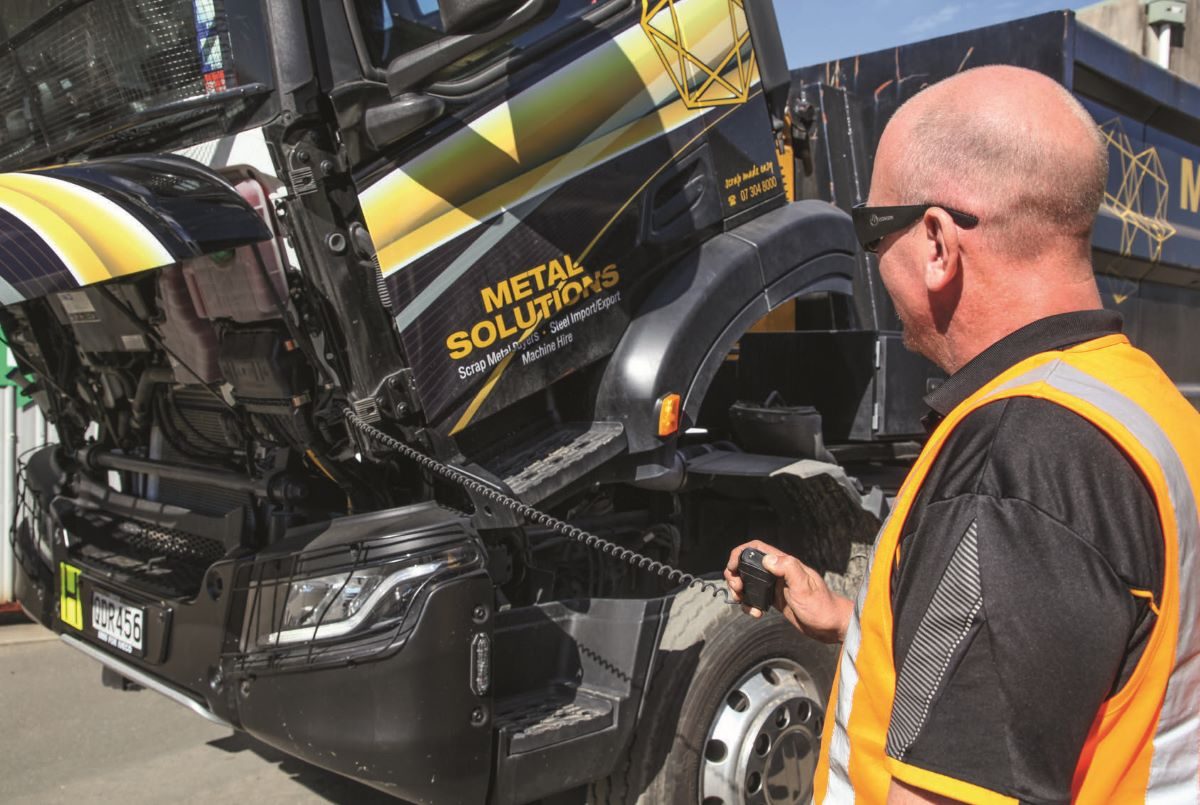
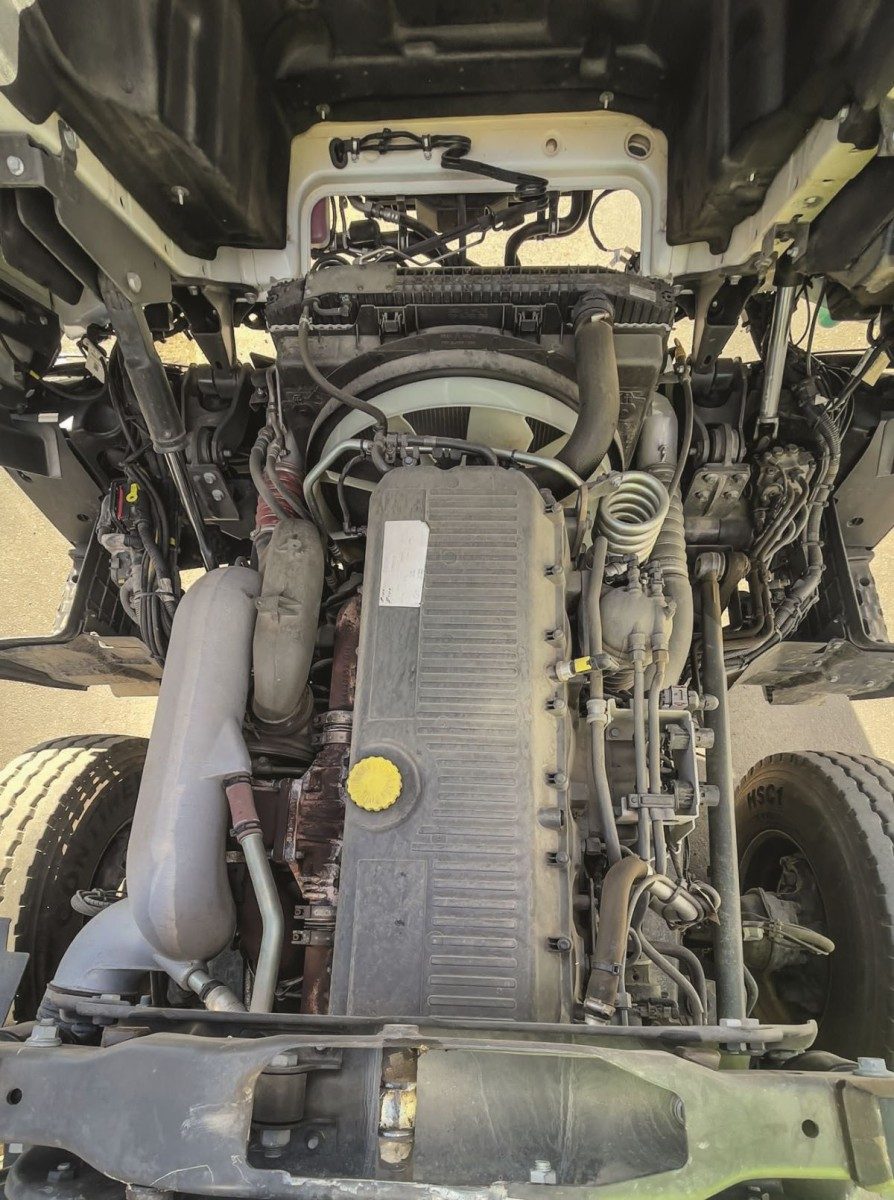
“It’s a good space. I’ve come out of bonneted day cabs, and it didn’t matter what I did, I was uncomfortable. I just couldn’t move the seat back enough. This has a telescoping steering wheel, so I put that as high as it goes. I put the seat as far back as it goes, and I’m happy,” comments Shannon, and as a 6ft 5in bloke, that’s saying a lot. It’s quiet, too, averaging about 68db at a cruise, rising to about 72db under load.
Speaking of which, we’re now well into our climb up and over the Kaimais. The Cursor 13 offers up 375kW (510hp) from 1560 to 1900rpm and 2300Nm (1696lb/ft) at 900rpm, which it maintains up to 1560rpm, handing over to the max power. “This thing has a good flat torque curve. It changes up and doesn’t seem to labour; it sits on the torque curve and keeps going. There are certain parts of the climb where it will actually gain speed. At the end of the day, I am going up here at 50 tonne, so anything better than 25km/h and I’m happy,” says Shannon.
On the last steep climb out of the Bay of Plenty leading to the summit, the 16-speed HI-TRONIX (ZF Traxon) AMT smoothly drops down a few cogs to 10th at 30km/h before settling in ninth at 26km/h and roughly 1700rpm. The engine fan kicks in – she’s sure pulling hard. By the time the climb levels out and we pass Old Kaimai Road, the T-Way has comfortably recovered speed, the HI-TRONIX box changing up without much pause for concern. Tenacious.
A three-stage engine brake is standard fitment, while a transmission intarder is optional. Shannon comments that it is the only option he would’ve ticked given the chance. However, that’s not to say the engine brake is suboptimal. Heading down the Kaimais into the Waikato, the engine brake provides strong hold-back, to the point Shannon backs it off now and then.
Later, climbing the Bombays, the T-Way holds a steady 25km/h in ninth.
Fuel efficiency to date (13,345km) is a very fair 2.07km/L.
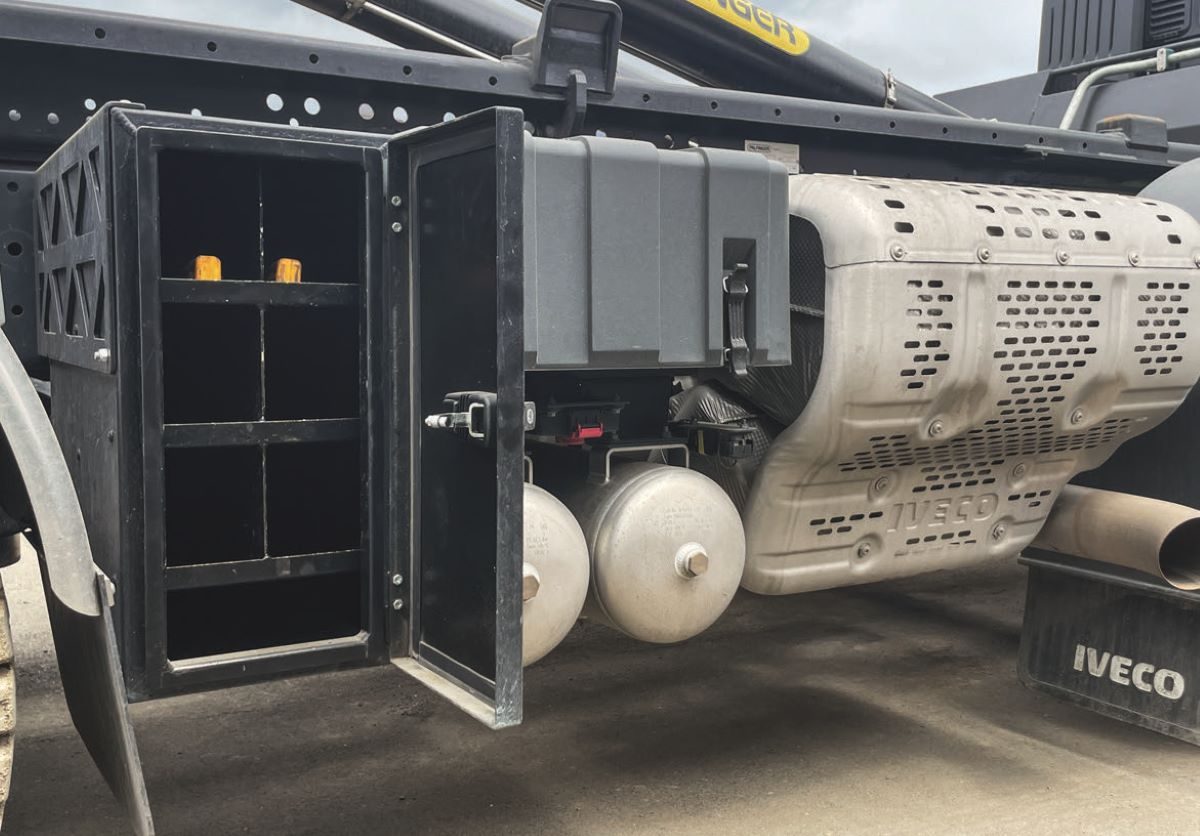
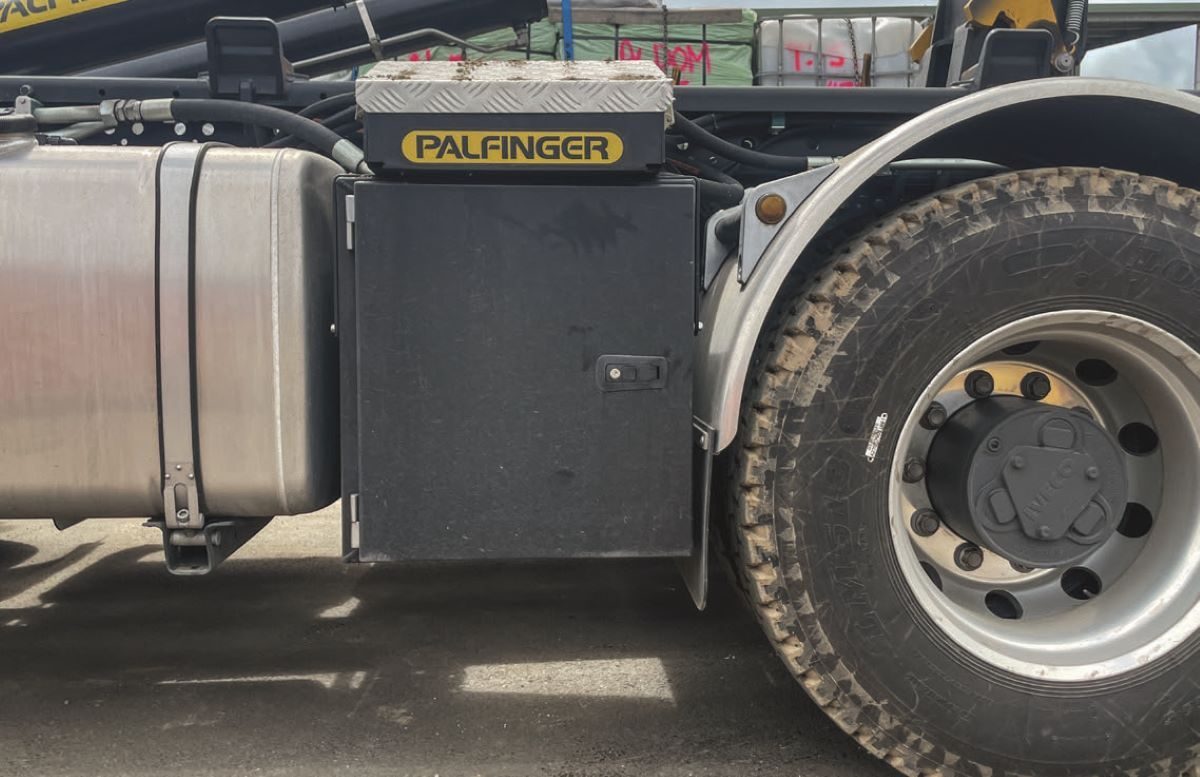
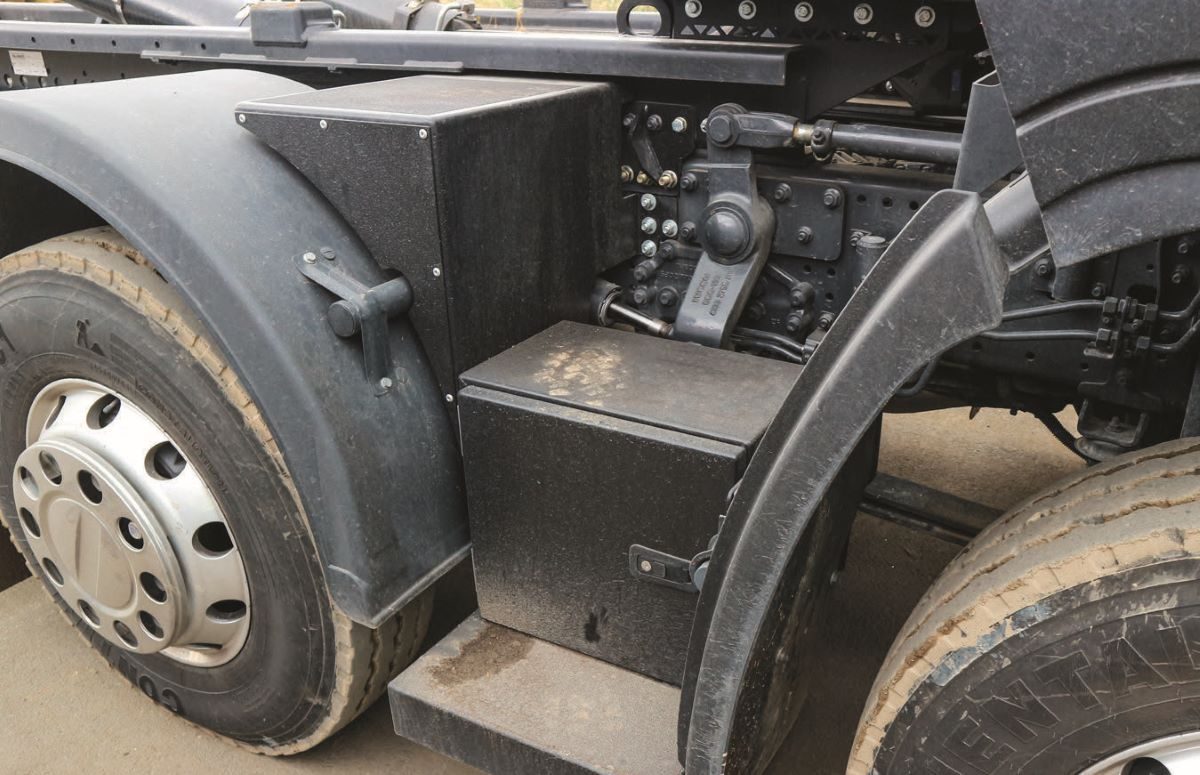
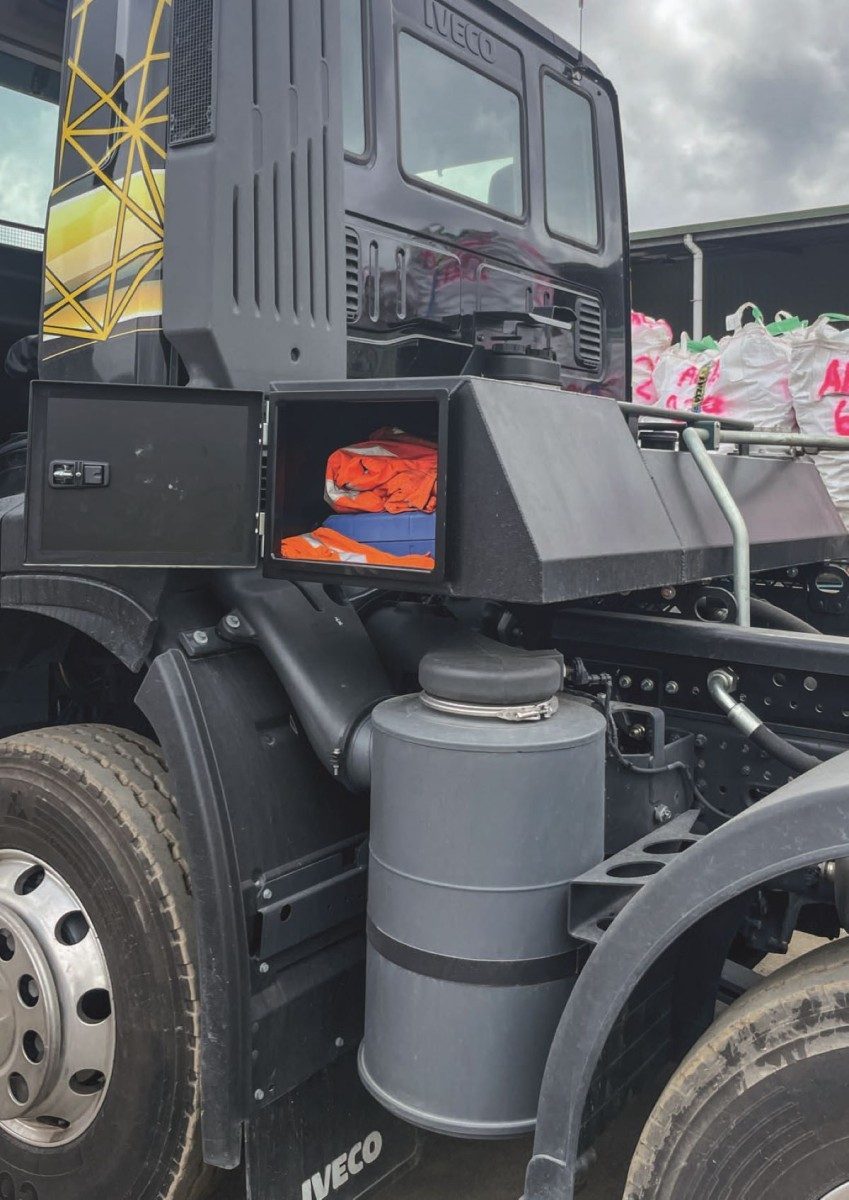
MSL ensured the T-Way had no shortage of cleverly integrated lockers.
To a ‘T’
While the T-Way may not have launched with the same level of fanfare and intrigue as the S-Way, there’s no doubt that those in the know would have been very excited and intrigued indeed. The Trakker had a formidable reputation worldwide for being able to tackle rough, tough jobs – and the Dakar Rally to boot. For the past three events, the T-Way has followed in its tyre tracks on the rally – but it’s performance on the job is what counts most. On first acquaintance, it would appear to be, well, on track.
Behind its purposeful looks (an iF Design Award winner in the Heavy Truck: Industrial Design category, a German Design Council German Design Award winner for Excellent Product Design, and a Red Dot Award winner for Product Design) lay proven underpinnings and an array of electronic smarts. Add to that comfortable, spacious – is this really a day cab? – environs, an easy-driving nature and an efficient but effective drivetrain, and nuggety, plucky, tenacious and intelligent come together in one impressive package.
Now, we just need to jump aboard one of those 410hp 4×4 units faced with a mountain to climb.
Special thanks
Our sincere thanks to Dave Fretwell and the MSL team for access to the T-Way, for letting us behind the scenes of the business and for giving us insight into the scrap metal industry. Thanks to Shannon de Vos for having us along in the cab and regaling us with your stories.
Thanks to Erwin Stolze and the team at Iveco New Zealand for your continued support of New Zealand Trucking magazine and to Brent Landers for the technical info on MSL’s T-Way.
Quick reads from Test
Read more
Of culture and longevity
0 Comments37 Minutes
Life’s essentials
0 Comments43 Minutes
Hiding in plain sight
0 Comments34 Minutes
Garth South
0 Comments2 Minutes




















